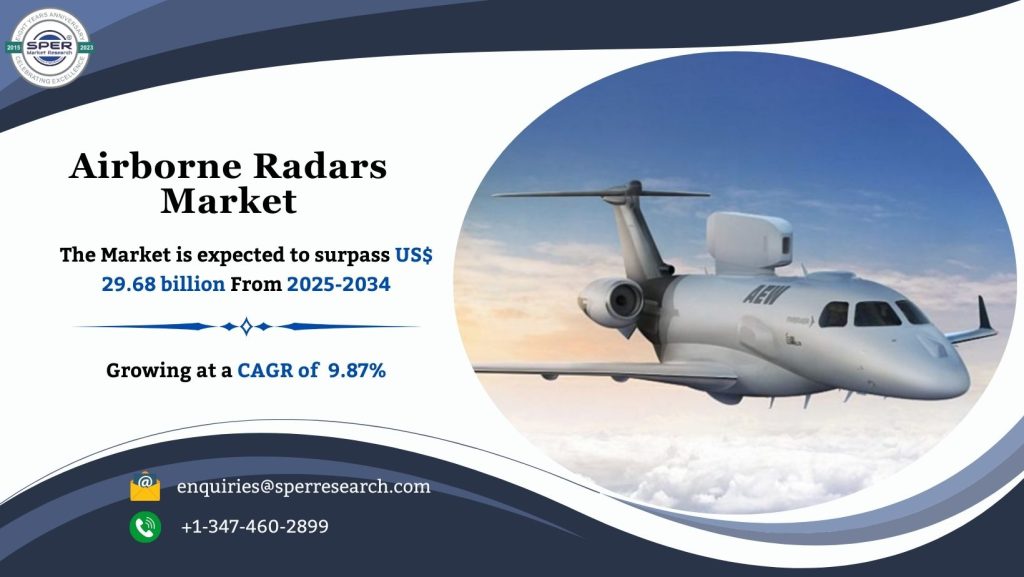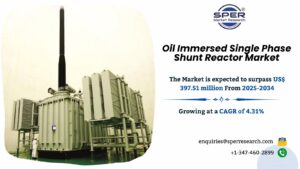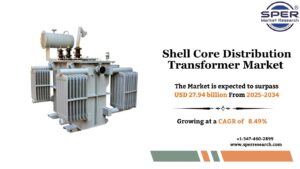Airborne Radars Market Size, Share, Industry Report, Growth and Future Opportunities 2034: SPER Market Research

Airborne radars are sophisticated radar systems installed on aircraft to identify, track, and monitor objects in the air, on land, and at sea. These radars are essential for surveillance, navigation, weather monitoring, and military operations. They utilize radio waves to detect targets, assess their distance, speed, and direction, and offer real-time situational awareness. Airborne radars are extensively employed in defense for threat detection, missile guidance, and reconnaissance, as well as in commercial aviation for air traffic control and weather forecasting. Key types include pulse-Doppler, synthetic aperture, and phased-array radars. Ongoing advancements in radar technology improve detection accuracy, range, and operational efficiency.
According to SPER market research, ‘Global Airborne Radars Market Size- By Component, By Mode, By Dimension, By Range, By Frequency Band, By Installation Type, By Application, By Technology Type – Regional Outlook, Competitive Strategies and Segment Forecast to 2033’ state that the Global Airborne Radars Market is predicted to reach 29.68 billion by 2034 with a CAGR of 9.87%.
Drivers:
Growing defense and security requirements, which result in higher investments in surveillance, reconnaissance, and early warning systems, are driving the market for airborne radars. The market is expanding more quickly due to the rising need for contemporary fighter planes, unmanned aerial vehicles, and commercial aircraft with sophisticated radar capabilities. Technological developments that improve detection accuracy and operational efficiency include downsizing, AI-powered signal processing, and active electronically scanned array (AESA) radars. Government spending on aerial radar equipment is further increased by growing border security concerns and geopolitical tensions. Furthermore, developments in space-based radar technology and the growing use of weather and navigation radars in commercial aviation are fueling industry expansion and innovation.
Request a Free Sample Report: https://www.sperresearch.com/report-store/airborne-radars-market?sample=1
Restraints:
High development and integration expenses are just one of the many obstacles facing the airborne radar sector, which makes adoption challenging for businesses with little resources. Strict export control and regulatory laws impede the growth of international markets. Complexity in system design is increased by technological challenges including minimizing size, weight, and power consumption without sacrificing performance. As radar systems grow more networked and data-driven, cyber security threats become more significant. Operational efficiency is impacted by radio frequency spectrum availability constraints and interference problems. Furthermore, lifetime and maintenance expenses are still substantial, which affects affordability over the long run. Growth in the industry is further limited by the requirement for qualified personnel to design and run sophisticated radar systems.
The market for airborne radars was controlled by North America. The market expansion in North America is fuelled in part by the rising need for intelligence, surveillance and reconnaissance (ISR), and border surveillance capabilities. Some significant market players are Lockheed Martin Corporation, Thales, Leonardo S.p.A.., Honeywell Aerospace, L3Harris Technologies, Inc. and Elbit Systems Ltd.
For More Information, refer to below link: –
Related Reports:
Follow Us –
LinkedIn | Instagram | Facebook | Twitter
Contact Us:
Sara Lopes, Business Consultant — USA
SPER Market Research
enquiries@sperresearch.com
+1–347–460–2899





